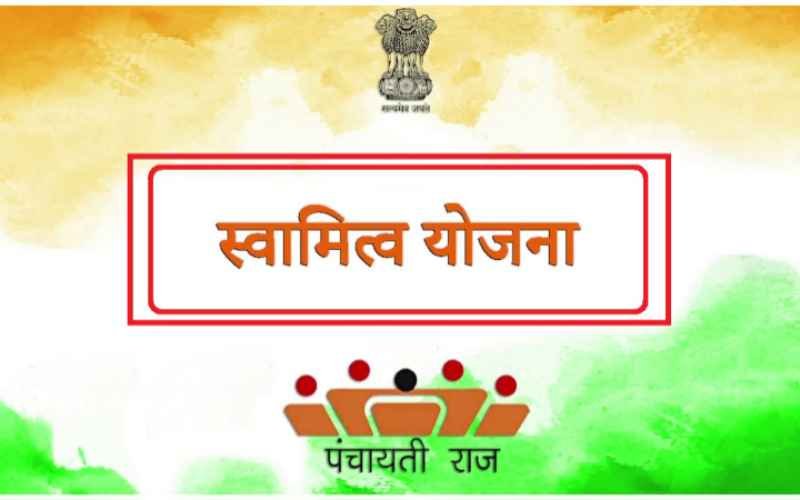Launched on April 24, 2020, by Prime Minister Narendra Modi, the Svamitva Yojana (Survey of Villages and Mapping with Improvised Technology in Village Areas) is a revolutionary scheme aimed at empowering rural citizens by providing them with an official document of property ownership. This initiative aims to create accurate land records for rural planning and reduce property disputes, fostering economic and social growth in rural India.

Objectives of Svamitva Yojana
- Property Ownership: To provide rural residents with official documents that validate ownership of their properties.
- Reduction of Property Disputes: Accurate land records will help in minimizing disputes related to property ownership.
- Financial Inclusion: With property documents, rural residents can avail of loans and other financial services, boosting economic activities.
- Planning and Infrastructure Development: Accurate land records facilitate better planning and development of rural infrastructure.
Key Features of Svamitva Yojana
- Drone Survey Technology: Utilizes advanced drone technology to create high-resolution maps of rural lands.
- Property Cards: Issuance of property cards (Svamitva Cards) to landowners, serving as official proof of ownership.
- Integration with Digital India: The scheme is integrated with the Digital India initiative, ensuring transparency and ease of access to land records.
- Collaboration with State Governments: The scheme involves close collaboration with state governments and Panchayati Raj institutions for implementation.
Implementation Process
- Survey and Mapping: Drones survey the village lands to create accurate maps.
- Verification and Validation: The collected data is verified and validated by the concerned authorities.
- Issuance of Property Cards: Once the data is verified, property cards are issued to the landowners.
- Integration with Land Records: The property details are integrated into the state land records database.
Benefits of Svamitva Yojana
- Legal Recognition: Provides legal recognition of property ownership to rural residents.
- Access to Financial Services: Enables landowners to access financial services such as loans and mortgages.
- Reduction in Disputes: Minimizes property disputes by providing clear ownership records.
- Economic Growth: Facilitates economic growth by enabling better planning and development of infrastructure.
- Enhanced Rural Governance: Improves rural governance through accurate land records.
Challenges and Solutions
- Technological Challenges: The use of advanced technology like drones may face initial resistance and require capacity building at the local level.
- Solution: Training and capacity-building programs for local officials and residents.
- Coordination with State Governments: Effective implementation requires seamless coordination with state governments.
- Solution: Establishing clear protocols and communication channels between the central and state governments.
Conclusion
The Svamitva Yojana is a transformative initiative that promises to bring about significant changes in rural India by providing clear property ownership, reducing disputes, and facilitating financial inclusion. By leveraging modern technology and fostering collaboration between different levels of government, the scheme aims to empower rural residents and contribute to the overall development of the country. As the implementation progresses, it is crucial to address the challenges effectively to realize the full potential of this groundbreaking initiative.
Svamitva Yojana: Top 20 FAQs with Answers
1. What is Svamitva Yojana?
Answer: Svamitva Yojana is a central government scheme launched on April 24, 2020, aimed at providing rural property owners with legal documents of ownership. It uses advanced technology, including drones, to map and survey village lands.
2. Who launched the Svamitva Yojana?
Answer: The Svamitva Yojana was launched by Prime Minister Narendra Modi.
3. What are the main objectives of the Svamitva Yojana?
Answer: The main objectives are to provide property ownership to rural residents, reduce property disputes, facilitate financial inclusion, and improve rural planning and infrastructure development.
4. How does Svamitva Yojana benefit rural residents?
Answer: It benefits rural residents by giving them legal recognition of their property, access to financial services, reduction in property disputes, and improved rural infrastructure and governance.
5. What technology is used in the Svamitva Yojana?
Answer: The scheme uses drone technology to create high-resolution maps of village lands.
6. What is a property card under Svamitva Yojana?
Answer: A property card, or Svamitva Card, is an official document issued to landowners that validates their ownership of the property.
7. How are property disputes minimized under Svamitva Yojana?
Answer: By providing clear and accurate records of property ownership, the scheme helps to reduce ambiguity and disputes related to property ownership.
8. How does the Svamitva Yojana support financial inclusion?
Answer: With property cards as legal proof of ownership, rural residents can avail loans and other financial services, thereby boosting economic activities.
9. What is the role of state governments in the Svamitva Yojana?
Answer: State governments collaborate closely with the central government and Panchayati Raj institutions to implement the scheme effectively.
10. How are the maps and property details validated?
Answer: The data collected by drones is verified and validated by local authorities before property cards are issued.
11. Is Svamitva Yojana integrated with Digital India?
Answer: Yes, the scheme is part of the Digital India initiative, ensuring transparency and ease of access to land records.
12. Who can benefit from the Svamitva Yojana?
Answer: Rural residents who own property in village areas can benefit from the scheme.
13. What are the challenges faced in the implementation of Svamitva Yojana?
Answer: Challenges include technological resistance, the need for capacity building, and coordination with state governments.
14. What measures are taken to overcome the challenges?
Answer: Solutions include training programs for local officials, establishing clear protocols, and enhancing communication channels between different levels of government.
15. How can rural residents obtain their property cards?
Answer: After the survey and validation process, property cards are issued to landowners by local authorities.
16. Can property cards be used for financial transactions?
Answer: Yes, property cards can be used to secure loans and other financial services.
17. What impact does Svamitva Yojana have on rural governance?
Answer: The scheme improves rural governance through accurate and transparent land records, facilitating better planning and development.
18. How does the Svamitva Yojana facilitate infrastructure development?
Answer: Accurate land records enable better planning and development of rural infrastructure projects.
19. Are there any legal implications of having a property card?
Answer: Yes, property cards provide legal recognition of ownership, which can be used in legal and financial transactions.
20. Where can I get more information about Svamitva Yojana?
Answer: More information can be obtained from the official website of the Ministry of Panchayati Raj, local government offices, or by contacting the Panchayati Raj institutions in your area.












